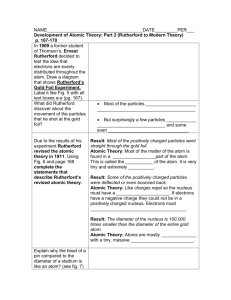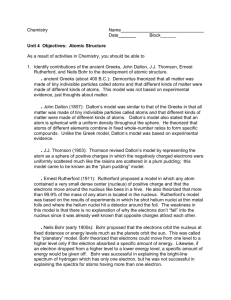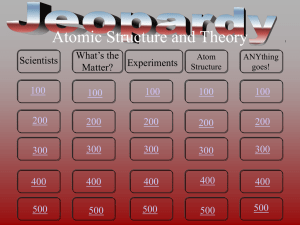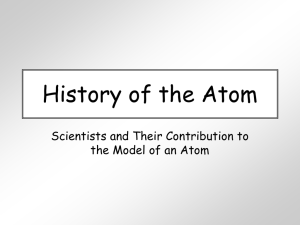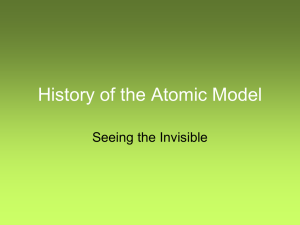Chapter 4 Notes
advertisement
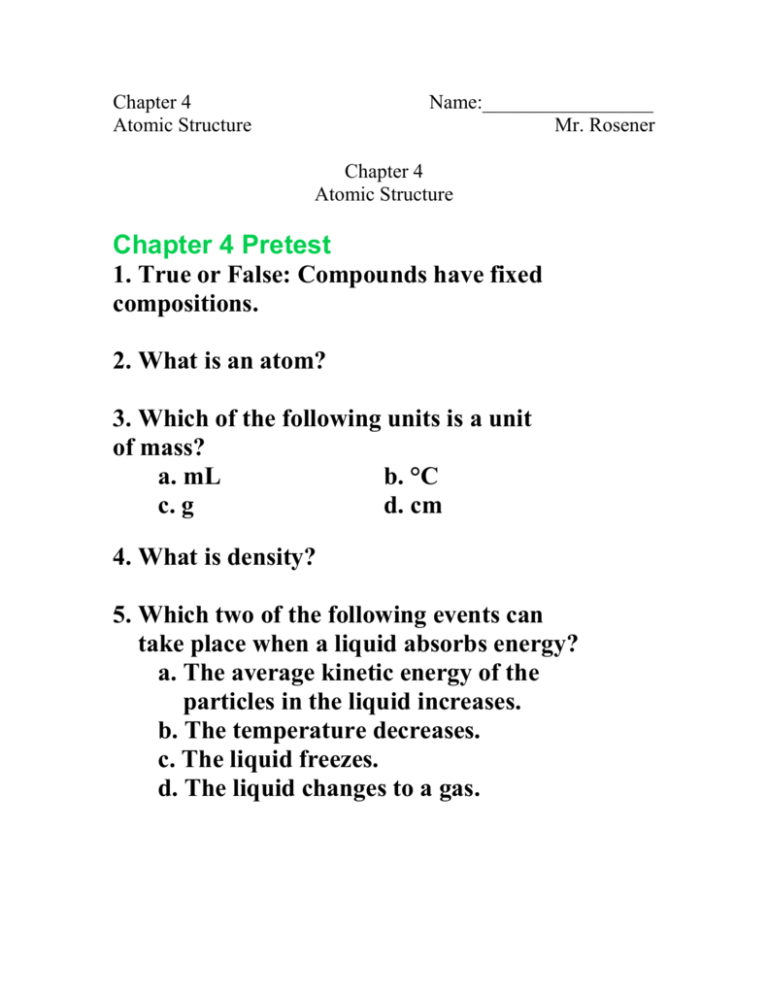
Chapter 4 Atomic Structure Name:_________________ Mr. Rosener Chapter 4 Atomic Structure Chapter 4 Pretest 1. True or False: Compounds have fixed compositions. 2. What is an atom? 3. Which of the following units is a unit of mass? a. mL b. °C c. g d. cm 4. What is density? 5. Which two of the following events can take place when a liquid absorbs energy? a. The average kinetic energy of the particles in the liquid increases. b. The temperature decreases. c. The liquid freezes. d. The liquid changes to a gas. Section 1: Studying Atoms Ancient Greek Models of Atoms • The philosopher __________________ believed that all matter consisted of extremely small particles that could not be divided. • He called these particles atoms from the Greek word atomos, which means “__________” or “________________.” • ___________________ did not think there was a limit to the number of times matter could be divided. • Aristotle thought that all substances were built up from only _____________ elements—earth, air, fire, and water • Which Philosopher was correct: Democritus or Aristotle? • For many centuries, most people accepted __________________ views on the structure of matter. • BUT • ____________________ would be proven correct by: John Dalton: Dalton’s Atomic Theory • Dalton studied the behavior of ____________ in air. • Dalton developed a theory to explain why the elements in a compound always join in the same way. • Dalton proposed the theory that all ____________ is made up of individual particles called ____________, which cannot be _________________. Dalton’s Atomic Theory • All elements are composed of ____________. • All atoms of the same element have the ___________ mass, and atoms of different elements have ____________ masses. • Compounds contain atoms of more than one ____________. • In a particular compound, atoms of different elements always ________________ in the same way. JJ Thomson: Thomson’s Model of the Atom • When some materials are rubbed, they gain the ability to ___________ or ______________ other materials. • Joseph John Thomson (1856–1940), better known as J. J. Thomson, used an electric current to learn more about atoms. • Thomson’s experiments provided the first evidence that ____________ are made of even _____________ particles. • He discovered the _____________. • Electron – ____________ charged particle found in the atom Thomson’s Model • In Thomson’s model of the atom, the _____________ charges were evenly scattered throughout an atom filled with a positively charged mass of matter. • The model is called the “____________ ____________” model, after a traditional English dessert. Ernest Rutherford: Rutherford’s Atomic Theory • In 1899, Ernest Rutherford discovered that uranium emits fast-moving particles that have a positive charge. • He named them ____________ particles • what happens to alpha particles when they pass through a thin sheet of _____________. Rutherford’s Hypothesis • hypothesized that the mass and charge at any location in the gold would be too ______________ to change the path of an alpha particle. • He predicted that most particles would travel in a _________ path from their source to a screen that lit up when struck. The Gold Foil Experiment • More particles were ________________ than he expected. • Some of the alpha particles behaved as though they had struck an object and bounced straight __________. Discovery of the ______________ • Rutherford concluded that the positive charge of an atom is not evenly spread throughout the atom. • It is concentrated in a very small, _____________ area that Rutherford called the _____________ • The _______________ is a dense, positively charged mass located in the center of the atom. Rutherford’s Atomic Theory • According to Rutherford’s model, all of an atom’s _____________ charge is concentrated in its ___________. • Rutherford also discovered the _______________ • Proton – __________ charged particle located in the nucleus Reviewing Concepts • 1. What theory did Dalton propose about the structure of matter? • 2. What evidence did J. J. Thomson provide about the structure of an atom? • 3. What did Rutherford discover about the structure of an atom? • 4. What evidence did Thomson have that his glowing beam contained negative particles? • 5. Why was Dalton’s model of the atom changed after Thomson’s experiment? Section 2: The Structure of an Atom Properties of Subatomic Particles • By 1920, Rutherford had seen evidence for the existence of two subatomic particles and had predicted the existence of a third particle. • Protons, electrons, and neutrons are _________ particles. Proton • A _______________ is a ______________ charged subatomic particle that is found in the nucleus of an atom. • Each proton is assigned a charge of +1. Electron • An _____________ is a ______________ charged subatomic particle that is found in the space outside the nucleus. • Each electron has a charge of -1. Neutron • In 1932, the English physicist James Chadwick designed an experiment to show that neutrons exist • A ______________ is a _______________ subatomic particle that is found in the nucleus of an atom. • It has a mass almost exactly equal to that of a __________. Comparing Subatomic Particles Protons, electrons, and neutrons can be distinguished by mass, charge, and location in an atom. Atomic Number and Mass Number Atomic Number • The ______________________ of an element equals the number of __________ in an atom of that element. • Atoms of different elements have different numbers of ________________. • Each positive charge in an atom is ______________ by a negative charge because atoms are neutral. • So the atomic number of an element also ____________ the number of electrons in an atom. What is the atomic number of the following elements. • Potassium (K) • Oxygen (O) • Iron (Fe) • Helium (He) Mass Number • The ________________of an atom is the ___________ of the protons and neutrons in the nucleus of that atom. • An atom of aluminum with 13 protons and 14 neutrons has a mass number of 27. • If you know the atomic number and the mass number of an atom, you can find the number of neutrons by ___________. Number of neutrons = __________________________________ What is the Atomic Mass of the following elements • Potassium (K) - Neutrons = 20 • Oxygen (O) – Neutrons = 8 • Iron (Fe) – Neutrons = 30 • Helium (He) – Neutrons = 2 Isotopes • _____________ are atoms of the same element that have different numbers of _________ and different mass numbers. • Isotopes of an element have the ________ atomic number but ______________ mass numbers because they have _________________ numbers of neutrons. • Hydrogen atom and it’s 3 isotopes • Hydrogen isotopes are the only isotopes to have special names. Hydrogen Deuterium Tritium Questions • What is the difference between Oxygen-16 and Oxygen-18? • How are they the same? • What part of the atom do isotopes have to do with? Reviewing Concepts • 1. Name three subatomic particles. • 2. Name three properties you could use to distinguish a proton from an electron. • 3. Which characteristic of an atom always varies among atoms of different elements? • 4. How are the isotopes of an element different from one another? • 5. What do neutrons and protons have in common? How are they different? • 6. How can atoms be neutral if they contain charged particles? • 7. What is the difference between atoms of oxygen-16 and oxygen-17? Section 3: Modern Atomic Theory Bohr’s Model of the Atom • Niels Bohr(1885–1962), a Danish physicist who worked for a while with Rutherford. • Bohr’s model focused on the ________________. • A description of the arrangement of electrons in an atom is the centerpiece of the modern atomic model. • Energy Levels • The possible energies that electrons in an atom can have are called _______________________. • An electron in an atom can move from one energy level to another when the atom _________ or __________ energy. • Scientists can measure the energy gained when electrons absorb energy and move to a __________ energy level. • They can measure the energy released when the electron returns to a ____________ energy level. Electron Cloud Model • An ___________________ is a visual model of the most likely locations for electrons in an atom. • Scientists use the electron cloud model to describe the possible locations of ______________ around the nucleus. When the propeller of an airplane is at rest, you can see the locations of the blades. When the propeller is moving, you see only a blur that is similar to a drawing of an electron cloud. Atomic Orbitals • An ______________ is a region of space around the nucleus where an electron is likely to be found • An electron cloud is a good approximation of how _______________ behave in their orbitals. Electron Configurations • A configuration is an ____________________ of objects in a given space. • An electron configuration is the arrangement of _________________ in the _______________ of an atom. • The most ___________ electron configuration is the one in which the electrons are in orbitals with the ___________ possible energies. • When all the electrons in an atom have the lowest possible energies, the atom is said to be in its __________________. Construct Bohr Models He C Mg Cl Models of the Atom DALTON MODEL THOMSON MODEL Sphere with The positive charge of the sphere balances the negative charge of the electrons Tiny, solid sphere 1803 John Dalton pictures atoms as tiny, indestructible particles, with no internal structure. - + - + + + + + - positive charge throughout Negatively charged particle (electron) 1897 J. J. Thomson, a British scientist, discovers the electron, leading to his “plum-pudding” model. He pictures electrons embedded in a sphere of positive electric charge. BOHR MODEL Electrons gain or lose energy when they move between fixed energy levels. RUTHERFORD MODEL Electron + Nucleus 1913 In Niels Bohr’s model, the electrons move in spherical orbits at fixed distances from the nucleus. + Nucleus Path of a moving electron 1911 New Zealander Ernest Rutherford states that an atom has a dense, Positively charged nucleus. Electrons move randomly in the space around the nucleus. ELECTRON CLOUD MODEL (Modern Thoery) The nucleus contains protons and neutrons. The electron cloud is a visual model of the probable locations of electrons in an atom. The probability of finding an electron is higher in the denser regions of the cloud. 1926 Erwin Schrödinger develops mathematical equations to describe the motion of electrons in atoms. His work leads to the electron cloud model. 1932 James Chadwick, a British physicist, confirms the existence of neutrons, which have no charge. Atomic nuclei contain neutrons and positively charged protons. Reviewing Concepts • 1. When is an electron in an atom likely to move from one energy level to another? • 2. What model do scientists use to describe how electrons move around the nucleus? • 3. Describe the most stable configuration of the electrons in an atom. • 4. What did Bohr contribute to modern atomic theory? • 5. What does an electron cloud represent?

